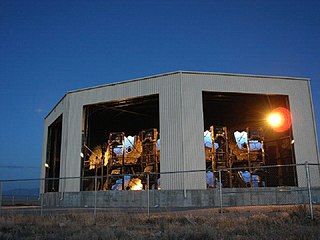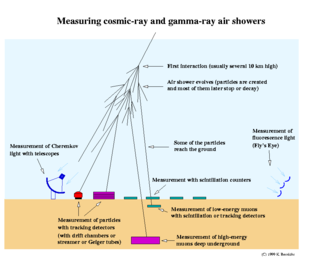
Super-Kamiokande is a neutrino observatory located under Mount Ikeno near the city of Hida, Gifu Prefecture, Japan. It is located 1,000 m (3,300 ft) underground in the Mozumi Mine in Hida's Kamioka area. The observatory was designed to detect high-energy neutrinos to search for proton decay, study solar and atmospheric neutrinos, and keep watch for supernovae in the Milky Way Galaxy.
The Greisen–Zatsepin–Kuzmin limit (GZK limit) is a theoretical upper limit on the energy of cosmic ray protons traveling from other galaxies through the intergalactic medium to our galaxy. The limit is 5×1019 eV, or about 8 joules. The limit is set by slowing interactions of the protons with the microwave background radiation over long distances (~160 million light-years). The limit is at the same order of magnitude as the upper limit for energy at which cosmic rays have experimentally been detected. For example, one extreme-energy cosmic ray has been detected which appeared to possess a record 3.12×1020 eV (50 joules) of energy (about the same as the kinetic energy of a 95 km/h baseball).

Neutrino astronomy is the branch of astronomy that observes astronomical objects with neutrino detectors in special observatories. Neutrinos are created as a result of certain types of radioactive decay, or nuclear reactions such as those that take place in the Sun, in nuclear reactors, or when cosmic rays hit atoms. Due to their weak interactions with matter, neutrinos offer a unique opportunity to observe processes that are inaccessible to optical telescopes.

HEGRA, which stands for High-Energy-Gamma-Ray Astronomy, was an atmospheric Cherenkov telescope for Gamma-ray astronomy. With its various types of detectors, HEGRA took data between 1987 and 2002, at which point it was dismantled in order to build its successor, MAGIC, at the same site.
The High Resolution Fly's Eye or HiRes detector was an ultra-high-energy cosmic ray observatory that operated in the western Utah desert from May 1997 until April 2006. HiRes utilized the atmospheric fluorescence technique that was pioneered by the Utah group first in tests at the Volcano Ranch experiment and then with the original Fly's Eye experiment. Dr. Pierre Sokolsky and Dr. George Cassidy, both of the University of Utah, received the 2007 Panofsky Prize for their work on this.
The Haverah Park experiment was a cosmic ray air shower detection array consisting of water Cherenkov detectors distributed over an area of 12 km2 on Haverah Park on the Pennine moorland near Harrogate, North Yorkshire. The experiment was operated by University of Leeds for 20 years, and was switched off in 1987.
The Akeno Giant Air Shower Array (AGASA) is a very large surface array designed to study the origin of ultra-high-energy cosmic rays. It covers an area of 100 km2 and consists of 111 surface detectors and 27 muon detectors. Array experiments such as this one are used to detect air shower particles.

The IceCube Neutrino Observatory is a neutrino observatory constructed at the Amundsen–Scott South Pole Station in Antarctica. Its thousands of sensors are located under the Antarctic ice, distributed over a cubic kilometre.

A neutrino detector is a physics apparatus which is designed to study neutrinos. Because neutrinos only weakly interact with other particles of matter, neutrino detectors must be very large to detect a significant number of neutrinos. Neutrino detectors are often built underground, to isolate the detector from cosmic rays and other background radiation. The field of neutrino astronomy is still very much in its infancy – the only confirmed extraterrestrial sources so far as of 2018 are the Sun and the supernova 1987A in the nearby Large Magellenic Cloud. Another likely source is the blazar TXS 0506+056 about 3.7 billion light years away. Neutrino observatories will "give astronomers fresh eyes with which to study the universe."
IMB, the Irvine-Michigan-Brookhaven detector, was a nucleon decay experiment and neutrino observatory located in a Morton Salt company's Fairport mine on the shore of Lake Erie in the United States 600 meters underground. It was a joint venture of the University of California, Irvine, the University of Michigan, and the Brookhaven National Laboratory. Like several other particle detectors, it was built primarily with the goal of observing proton decay, but it achieved greater fame through neutrino observation, particularly those from Supernova SN 1987A.
The Kamioka Observatory, Institute for Cosmic Ray Research is a neutrino and gravitational waves laboratory located underground in the Mozumi Mine of the Kamioka Mining and Smelting Co. near the Kamioka section of the city of Hida in Gifu Prefecture, Japan. A set of groundbreaking neutrino experiments have taken place at the observatory over the past two decades. All of the experiments have been very large and have contributed substantially to the advancement of particle physics, in particular to the study of neutrino astronomy and neutrino oscillation.
Milagro was a ground-based water Cherenkov radiation telescope situated in the Jemez Mountains near Los Alamos, New Mexico at the Fenton Hill Observatory site. It was primarily designed to detect gamma rays but also detected large numbers of cosmic rays. It operated in the TeV region of the spectrum at an altitude of 2530 m. Like conventional telescopes, Milagro was sensitive to light but the similarities ended there. Whereas "normal" astronomical telescopes view the universe in visible light, Milagro saw the universe at very high energies. The light that Milagro saw was about 1 trillion times more energetic than visible light. While these particles of light, known as photons, are the same as the photons that make up visible light, they behave quite differently due to their high energies.

Main Injector Experiment for ν-A, or MINERνA, is a neutrino scattering experiment which uses the NuMI beamline at Fermilab. MINERνA seeks to measure low energy neutrino interactions both in support of neutrino oscillation experiments and also to study the strong dynamics of the nucleon and nucleus that affect these interactions.

The Telescope Array project is an international collaboration involving research and educational institutions in Japan, The United States, Russia, South Korea, and Belgium. The experiment is designed to observe air showers induced by ultra-high-energy cosmic ray using a combination of ground array and air-fluorescence techniques. It is located in the high desert in Millard County, Utah (USA) at about 1,400 meters (4,600 ft) above sea level.

A cosmic-ray observatory is a scientific installation built to detect high-energy-particles coming from space called cosmic rays. This typically includes photons, electrons, protons, and some heavier nuclei, as well as antimatter particles. About 90% of cosmic rays are protons, 9% are alpha particles, and the remaining ~1% are other particles.

NEVOD is a neutrino detector and cosmic ray experiment that attempts to detect Cherenkov radiation arising from interactions between water and charged particles. It represents the first attempt to perform such measurements at the Earth's surface; it is because of this surface deployment that the experiment is also able to investigate cosmic rays. NEVOD is situated at the Moscow Engineering Physics Institute (MEPhI).
Large Apparatus studying Grand Unification and Neutrino Astrophysics or LAGUNA is a European project aimed to develop the next-generation, very large volume underground neutrino observatory. The detector should be much bigger and more sensitive than any previous detector, and make new discoveries in the field of particle and astroparticle physics. The project involves 21 European institutions in 10 European countries, and brings together over 100 scientists. As of 2011, the project is assessing the feasibility of developing the observatory-infrastructure and the observatory particle detectors themselves, as well as looking for deployment site in Europe. There have also been propositions of merging the project with similar international projects, like DUSEL.

John David Linsley (12 March 1925 – 25 September 2002) was an American physicist who performed pioneering research on cosmic rays, particularly ultra-high-energy cosmic rays. He did his most significant work from 1959 to 1978 using a ground-based array of detectors at Volcano Ranch in New Mexico. He is best known for being the first to detect an air shower created by a primary particle with an energy of 1020 eV. This was the highest energy cosmic ray observed up to that point. Linsley's observations suggested that not all cosmic rays are confined within the galaxy and showed the first evidence of a flattening of the cosmic ray spectrum at energies above 1018 eV.












